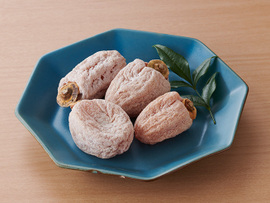
Noto Shiga Korogaki

IshikawaNoto Shiga Korogaki
Classification (Large)
Agricultural products
Classification (Small)
Other processed agricultural products
Main ingredients used
Saisho persimmons
When using downloaded images, please read the "Terms of Use" and clearly state that the source of the image is "Traditional Foods in Japan" by the Ministry of Agriculture, Forestry and Fisheries.
If the photo credits is stated, please include it as well.
Example of description
of the photo credits
Example of description when the photo credits is not stated
Source: "Traditional Foods in Japan" Ministry of Agriculture, Forestry and Fisheries
Example of description when the photo credits is stated
Source: "Traditional Foods in Japan" Ministry of Agriculture, Forestry and Fisheries
Photo credits:xxx
Region of inheritance
Shika Town, Hakui County
Product overview (special characteristics and types)
Noto Shika Korogaki are dried persimmons made in Shika Town, Hakui County, Ishikawa Prefecture, and are popular as sweets for New Year’s. The Saisho persimmons used are local Shika Town persimmons specially grown to be dried, and are categorized as a type of fully astringent persimmon. Noto Shika Korogaki have an oblong shape and amber color, with dense and soft meat. The sugar content is approximately 20 degrees on average, offering an exquisite sweetness.
History and culture
It is said that making Korogaki started when farmers produced these persimmons for their own consumption during the Edo period. Noto Shika Korogaki are believed to have originated in 1889 from farmers in the former Kamo Village and Shimoamada Village of Shika Town through selection of the best persimmon strains for drying. Production of the current Saisho persimmon for sales started around 1932, and up to around the 1950s, production was mostly conducted as a winter side job for farmers. However, due to a persimmon planting production project in Shika Town in 1988, production started in earnest with the expansion of growing areas and incorporation of machines for harvest and processing.
Production method
Harvest is from late October to mid-November, and the fruits are ripened until they are optimal for processing in mid-November, when the harvest reaches its peak. When the color of the skin at the bottom of the fruits reaches a certain standard, the stem caps and skins are removed using stem-removing machines and peelers. These persimmons are then tied to the ends of strings and hung from items such as bamboo poles. Next, the hung persimmons are smoked with sulfur for approximately 25 minutes and moved to a drying area, where they are naturally dried for two to three weeks. After this, the hung persimmons are moved to a drying room in which each fruit is kneaded by hand, with much care given to the temperature and humidity, until the meat is softened. Stoves and heaters are used to dry the persimmons for approximately one week. The kneading by hand provides even moisture and fruit meat distribution and enables moisture to escape more easily. When there is no more moisture visible on the fruits’ surface even after heating is stopped, the hung persimmons are moved from the drying room to the finishing room. As the last step, the fruits are stored in a dark, cool place and are complete when fructose crystals appear on the surface of the persimmons. The season for Korogaki is early December to late February.
Conservation and succession efforts
The quantity of these persimmons that is shipped has gradually declined due to the aging population of the producers and lack of successors, and for now, shipments have dropped to less than half of the 70,000 boxes produced at their peak in 1992. For this reason, JA Shika established the [Korogaki Sectional Meeting] in 1993. This organization makes efforts such as standardizing the harvesting methods of the Saisho persimmon and creating processing manuals to establish a system that enables steady shipment of the products. Furthermore, to promote the production area of Korogaki, the Nakanoto Agriculture and Forestry General Office has cooperated with organizations, such as JA, to start the [Shika: Home of the Korogaki Revitalization Project] in 2015. In addition to this, with its October 2016 registration in the Geographical Indication Protection System (GI), efforts toward branding with GI are also being made, and the highest standard [Premium] of the Noto Shika Korogaki were shipped out in 2019. The products have also been exported to regions such as Taiwan from 2017 to meet demands for Chinese New Year’s. In 2022, the products have been certified as the [Best of the Best] for Ishikawa prefectural brand agricultural, forestry, and fishery products.
Main consumption method
It is standard practice to eat the fruits as they are, such as for snacks served with tea. They are also used as year-end and New Year’s gifts.
At-home recipes:Namasu containing Noto Shika Korogaki
Ingredients
Noto Shika Korogaki
2 pcs.
Japanese radish
1/2 radish
Carrot
1/2 carrot
Salt
1/2 teaspoon
[A] Salt: 1/2 tablespoon Sugar: 4 tablespoons Vinegar: 1/2 cup
How to make
Cut dried persimmon into strips. Cut Japanese radish and carrot into 4-cm strips, sprinkle salt on them, let them sit for a while, and squeeze out the water.
Put the ingredients from A in a bowl and mix well. Add the dried persimmon, Japanese radish, and carrot from 1 above, and toss them in the dressing.

